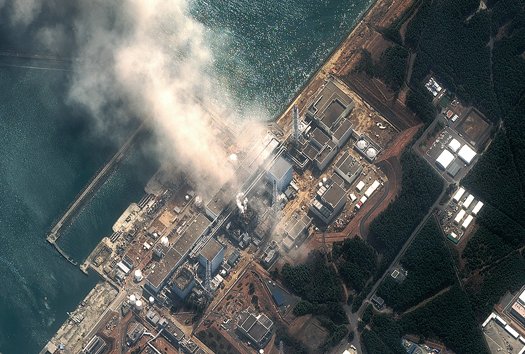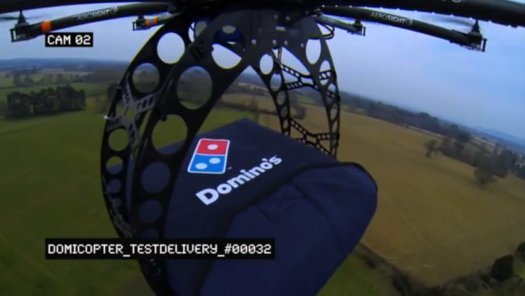 7 Of The Best Gimmick Drones Drones that deliver cake, beer, pizza, and more By Kelsey D. AthertonPosted 08.05.2013 at 2:30 pm0 Comments Pizza drone! Domino's View Photo Gallery Click here to enter. Drones, despite years of experience at war, are not yet a technology that's ready for widespread commercial use. That hasn't stopped businesses, including pizza restaurants, dry cleaners, and cake companies, from cashing in on the future prematurely. These drones, often converted toy models, are typically enlisted to deliver goods, even though they can be pretty wobbly, and they don't carry a whole lot. They are also not terribly cost-effective, especially when compared with a twentysomething with a bike looking to make some spare beer money. But the drones don't actually need to be good at what they do. Simply by virtue of being drones, they've already served as news-catching gimmicks and cheap ad pitchmen. Here are seven of the best--by which we mean silliest--gimmick drones. Chernobyl Now Click here to see this amazing image even larger. Left: Karen Kasmauski/Corbis; Right: Steve Featherstone 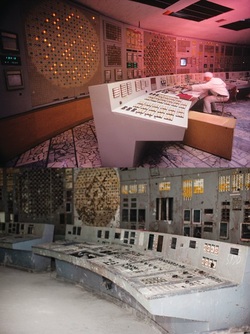 On April 26, 1986, two powerful explosions tore through Unit 4 of the Chernobyl nuclear power plant, flipping the reactor’s giant 2,000-ton concrete lid into the air like a coin. White-hot chunks of the nuclear core rained down on adjacent buildings, setting fires and peppering the ground outside. Remnants of the core burned for 10 days, churning a thick plume of radioactive isotopes equivalent to 400 Hiroshima bombs high into the atmosphere. 1. “WHAT DOES THAT TELL YOU ABOUT SAFETY?” Although Chernobyl contaminated half the planet with fallout, memory of the disaster had almost faded into obscurity when a tsunami swamped Japan’s Fukushima Daiichi power plant last year. At the time, many observers resurrected the specter of Chernobyl as a reassuring example of what wasn’t happening at Fukushima—a nuclear meltdown. We know now, though, that three of Fukushima’s reactors did melt down, spewing radioactive contamination over parts of Japan and into the sea. Twenty-five years separate Chernobyl from Fukushima, but the occurrence of nuclear meltdowns is more frequent than this span suggests. The nuclear power industry measures safety trends in “reactor-years.” One reactor-year is equivalent to one nuclear reactor generating electricity for one year. The Nuclear Regulatory Commission’s safety goal for U.S. reactors is one incident in every 10,000 reactor-years. Thomas Cochran, a physicist and consultant for the Natural Resources Defense Council, calculates that the world’s fleet of light-water power reactors has racked up 11,500 reactor-years and counts five “partial core melt” accidents (“nuclear meltdown” is a term of art with no well-defined meaning) thus far worldwide. He credits Fukushima with three partial core melts. Three Mile Island and Greifswald, a plant in the former East Germany, account for the other two. (Chernobyl is not on the list because it was an old Soviet design used in only a handful of nuclear power plants in operation today.) “Historically, that means 1 percent of light-water reactors have had a partial core melt,” Cochran says. “One percent is a lot higher than one in every 10,000 reactor-years. What does that tell you about safety?” In fact, the global rate is about five times the baseline goal of U.S. regulators. If the rate of partial core melts holds true for the 353 light-water reactors currently operating, we can expect a nuclear meltdown to occur every six years on average. From a historical perspective, Chernobyl isn’t just a curious artifact of the Cold War; it is one of the first events in a growing trend, and we are only now beginning to understand how to cope with its fallout. 2. “A HOUSE OF CARDS” While Japanese emergency workers fought to stabilize Fukushima’s overheated reactors, Ukrainian construction crews half a world away began an important new phase in Chernobyl’s protracted cleanup, bulldozing the contaminated soil around the steel-and-concrete tomb that encloses the scorched wreckage of Unit 4’s reactor building. The Shelter, as the tomb is known in Ukraine, was designed to last 15 years. More then a decade after that deadline, it still looms above the complex like a medieval fortress. “It’s a house of cards,” said Eric Schmieman, a senior technical adviser for the Shelter Implementation Plan, the organization charged with maintaining the Shelter. Schmieman was standing outside SIP’s office building, located several hundred yards from the Shelter. He explained how Soviet engineers cobbled it together in just six months. The north wall is a stack of debris-filled concrete forms. The south wall consists of steel panels propped against girders. The steel plates that make up the roof are affixed by gravity alone. “They didn’t have a guy up there saying, ‘Move it another foot,’ ” Schmieman said. “It was all done by crane.” “This is kind of like what working on the pyramids must have been for engineers back in Egyptian times.”Some 480,000 cubic yards of concrete and 7,300 tons of steel went into the Shelter, and it is held in place mostly by friction and luck. When Soviet workers finished building the Shelter, it was riddled with holes the size of picture windows. Leaking water corroded the steel support beams. A large crack was buckling the west wall. Birds flew in and out, spreading radioactive contamination. Ukraine inherited the crumbling Shelter after the Soviet Union broke up. By then it had become even more dangerously unstable, and Ukraine didn’t have the money or expertise to repair it. The G7 nations agreed to fund a complete rehab of the Shelter in 1997. They chartered SIP to oversee dozens of projects: plugging holes in its walls, replacing its roof, stabilizing its west wall and ventilation stack, installing monitoring equipment, and so on. In essence, the Shelter had to be fixed up in order for it to be safely torn down. The costliest project to date, and the last in SIP’s mandate, is the New Safe Confinement, a $1.3-billion arch that will, if all goes well, completely seal off the Shelter from the environment. Schmieman, the principal member of the arch’s conceptual design team, has tackled complex engineering problems all over the world. But the arch, he said, is by far the most challenging project he’s ever worked on. Everything about the arch—its size, its purpose and the hazardous conditions under which it’s being built—is unprecedented. Now he grinned. “This is kind of like what working on the pyramids must have been for engineers back in Egyptian times.” Ground Control: Workers are preparing a foundation on which to construct the world’s largest movable structure. It will eventually cover what remains of Chernobyl’s damaged Unit 4, just 500 yards to the east [at center]. Steve Featherstone 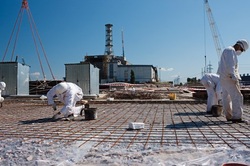 3. “THE BOGEYMAN IN EVERY EQUATION” Dust, the most mobile and breathable of radioactive contaminants, is an ever-present threat at Chernobyl. Radiation-detection portals at the entrance to every building scan feet and hands for contaminated dust. Mop-wielding women swab floors around the clock. Tanker trucks patrol the arch’s construction site, spraying water to keep dust from blowing around. And nobody pets the feral cats prowling the streets because their fur is dusted with the radioisotopes cesium-137, strontium-90 and plutonium-239. Iodine-131 is another dangerous radioisotope released during nuclear accidents. It mimics ordinary iodine, collecting in thyroid glands and giving rise to thyroid cancers years down the road. But iodine-131 decays to safe levels within a few weeks. Cesium and strontium, which mimic potassium and calcium, two minerals critical to the function of healthy ecosystems, persist in the soil and water, in plants and animals, for decades. The radioactive “ground shine” that makes Geiger counters click faster in contaminated areas is mostly the product of cesium decay. Plutonium, the stuff that nuclear bombs are made of, doesn’t contribute much to overall radiation levels at Chernobyl, but it’s nonetheless the most deadly of the inhalants. “Radioactive contamination is typically not a dose problem as long as you don’t get it internally,” cautions Mark Fishburn, SIP’s biomedical project manager. “Inhalation, ingestion or injection—that’s the way you get dosed here.” During the meltdown, the nuclear fuel in Chernobyl’s core turned into slag hot enough to burn through four feet of concrete and steel. The slag flowed like lava down steam pipes into the floors below, where it solidified into glassy black blobs straight out of a science-fiction movie. Scientists categorize these blobs as “fuel-containing materials,” or FCMs. About 200 tons of extremely radioactive FCMs are buried in the rubble of Unit 4, and they are the source of plutonium-laced “fuel dust.” Once a year, the Shelter’s dust-suppression system, a series of nozzles visible on the Shelter’s roof, douses the ruins of Unit 4 with a chemical fixative that binds up loose dust particles. Most of Unit 4 is off limits to visitors, but I was allowed to see the control room. After squeezing through a dark, narrow passage, I found myself standing in the middle of what appeared to be a set from an old episode of Star Trek. Three bulky consoles studded with black knobs stood in front of a semicircular wall of gray metal panels. All the instruments were gone except for a few analog gauges dangling from bundles of wire. Everything was encrusted in a rime of dust and dried red fixative. My Ukrainian guide warned me not to touch anything even though I was wearing an anti-contamination suit. “Plutonium,” he intoned. Scientists have explored only a third of the cave-like ruins inside the Shelter. Many basement rooms are knee-deep in water that, as it evaporates, causes FCMs to oxidize and shed tiny particles of fuel dust into the air. Scientists estimate that the Shelter contains 33 tons of the stuff, a daily hazard and a disaster in the making. “The smallest particles don’t settle with gravity,” Schmieman says, “but stay suspended in the air. It’s a big problem.” If the Shelter collapsed, the resulting cloud of contaminated dust and debris would be disastrous. Thousands of Chernobyl workers could receive doses 25 times the annual limit. Now that SIP has stabilized the Shelter, the chances of it collapsing are slim. But dust remains a major threat. “The bogeyman in every equation,” Schmieman says, “is how to keep radioactive dust from spreading.” 4. “IT’S MUCH MORE COMPLICATED THAN THAT” Ukrainian authorities once considered drilling through the side of the Shelter to access the FCMs, but engineers wisely deemed the Shelter too unstable. The only way to retrieve them without collapsing the Shelter, exposing workers to excessive radiation, or spreading contamination, would be to pull the Shelter itself apart piece by piece in a controlled environment. The arch of the New Safe Confinement will provide that environment. The deadline for completing the arch was this April, but Novarka, the French consortium that won the contract to build it, has only recently wrapped up extensive ground preparations. The new deadline is December 2015. Laurin Dodd, SIP’s managing director, considers even that date “ambitious.” In computer renderings taped to his office walls, the arch looks like an oversized Quonset hut. At 280 yards wide, 160 yards long and 115 yards tall, it could swallow a college football stadium with the Statue of Liberty standing on the 50-yard line. “It’s easy to think of the arch as a big barn or something, but it’s much more complicated than that,” Dodd says. The Soviet engineers used standard construction cranes to build the Shelter; to demolish it, Ukrainian engineers will employ a custom-fabricated tensile-truss crane system suspended from the arch’s ceiling on a web of cables. Television networks use similar technology to swoop cameras over the playing field during football games. The arch’s crane system will be equipped with cameras as well, in addition to a manipulator arm, two 50-ton hoists, a drill, a jackhammer, hydraulic shears and a 10-ton vacuum cleaner. Operators will be able to peel back the Shelter’s roof from the safety of a shielded control room, in effect making the arch the world’s biggest glove box for handling radioactive materials. The toughest engineering challenge was designing a ventilation system for the arch that will circulate seven million cubic feet of air without lofting fuel dust. At the same time, the air must move fast enough to prevent rain clouds from forming inside the arch and causing its tubular steel skeleton to rust. Schmieman ran simulations—“millions and millions of calculations”—on software tailored for global climate research and industrial clean-room studies. He calibrated air velocities and tweaked airflow patterns until he struck a delicate balance between humidity control and the speed at which a single mote of dust settles to the ground. The real genius of the arch isn’t so much in its design, though, but in the decision to build it on less-radioactive ground 300 yards west of the site. Other companies proposed to erect a confinement structure directly over the Shelter, where dose rates are highest; more radiation translates to more workers working shorter shifts, and therefore greater costs. Once the arch is complete, it will slide to its final resting position over the Shelter on two stainless-steel rails embedded in massive concrete “ground beams.” If it works, the arch will be the largest movable structure on Earth. Toxic Debris: Constructing Unit 4 was difficult. Removing its remains will be even harder. Left: AP Photo: Right: Igor Kostin/Sygma/Corbis  5. “YOU WOULD EXPOSE NUMEROUS PEOPLE” An obligatory stop on Chernobyl bus tours is the small visitors center, which is at the edge of a parking lot a quarter-mile from the Shelter. A big glass window provides an unobstructed view of the Shelter, but otherwise there’s not much to see. A dusty scale model of the Shelter sits next to a television playing a Novarka video of the New Safe Confinement project. Near the end of the nine-minute animation, the striped ventilation stack rising above the Shelter magically disappears as the arch glides into place. SIP has scheduled the vent stack to be completely removed by 2014, but the job most likely won’t go quite as smoothly as it’s depicted in Novarka’s video. Dodd calls it one of the “highest-risk” projects SIP has ever managed. Risky because the vent stack is enormous, reaching higher than a 40-story building and weighing more than 300 tons. Riskier still because it’s been discharging radioactive aerosols for 26 years and towers over a fragile structure filled with nuclear waste. “If you were to drop that thing on the building, you would expose numerous people that are out here working to the contamination,” says Marsha Brown, SIP’s site-works specialist. “It could be a terrible accident.” “The smallest radioactive particles don’t settle with gravity but stay suspended in the air. It’s a big problem.”The plan is to cut the vent stack into seven pieces and lift them off one at a time. The most important risk factor is radiation exposure to workers. The dose rate near the vent stack is “very high, about one rem per hour,” Schmieman says. SIP is considering installing shielded walkways on the roof to dampen workers’ exposure to gamma radiation, but the men slicing up the chimney will have to wear extra gear to protect themselves from poisonous dust and smoke. The effects of acute radiation doses are well-documented in studies of atomic-bomb survivors. We know, for instance, that a fatal dose in 100 percent of cases is 1,000 rems. The International Atomic Energy Agency attributes 28 radiation deaths to Chernobyl, mostly firemen exposed to extreme gamma radiation in the first hours of the catastrophe. No one has received a fatal dose at Chernobyl, or any other nuclear power plant, since the disaster. The United Nations issued a report in 2005 forecasting that an additional 4,000 people who received lower doses at Chernobyl will die from cancer. The death toll is already closer to one million, according to a compilation of Russian and Ukrainian research recently published by the New York Academy of Sciences. The huge discrepancy underscores our profound lack of knowledge about what low-dose radiation does to the human body. No regulatory institution in the world has established a “safe” dose of radiation. Every country sets its own limits. During the Fukushima disaster, Japan more than doubled its maximum dose limit for nuclear workers, simply to keep emergency operations going. The maximum allowed in Ukraine, which has one of the strictest dose standards in the world, is two rems per year (the limit is five rems per year in the U.S.). The legal limits govern how SIP and Novarka design their work plans; without shielding in place, workers at the vent stack would reach their annual dose limit in just two hours. But only certain kinds of exposure can be predicted. Although radiation levels at the vent stack and other areas of the site are well known, the amount of contaminated dust and aerosols workers will encounter is less certain. In addition to wearing dosimeters, all workers must submit to nasal swabs, urinalysis and fecal sampling to keep tabs on their dose. 6. “THEY’RE GOOD AT MAKING RULES” Last spring, Novarka transformed the weed-choked field west of the Shelter into a busy construction site. Workers scraped off the top layer of contaminated soil, brought in clean fill to reduce radiation coming from the ground, and dug two parallel trenches running from the west end of the site to the Shelter on the east end. The trenches would hold foundations for the stainless-steel rails by which the arch will be transported to the Shelter. Each trench is 500 yards long, and the distance between them (almost 300 yards) is the same width as the arch. By summer, cement mixers and dump trucks were rumbling across the site. The air reverberated with the piercing metallic clang of hydraulic hammers pounding steel piles into the bottoms of trenches, 396 in all. Each pile is 80 feet long and three feet in diameter; together they will support the weight of the 32,000-ton arch as it’s being built. Driving piles and digging trenches have progressed more slowly than expected. “Every time anybody does any excavation, they find stuff,” Dodd says. “Sometimes stuff is large cranes that were buried after the accident. Sometimes it’s trucks or Caterpillars. And sometimes it’s fuel-containing material.” The explosions that destroyed Unit 4 scattered bits of highly radioactive nuclear fuel called “hot particles” all around the site. Dosimetrists discover them during routine scanning of excavated dirt. When that happens, all nearby activity stops until a worker scoops up the particle using a shovel with a 10-foot handle. “The dose rate drops very quickly as you move away from it,” says Don Kelly, SIP’s health and safety engineer. “But as you’re right beside it, or carrying it around in your pocket, it’s smoking.” Kelly inspects the construction site every week. He carries a camera in his jacket pocket to document any safety violations he encounters. One afternoon last September, I walked with him along the north trench into the Shelter’s shadow. We paused to watch a continuous flight augur, a Caterpillar fitted with a giant corkscrew, drilling a borehole in the bottom of the trench. The process is gentler than banging steel piles into the ground, an important consideration this close to the Shelter. Seismic vibrations, which had already cracked the brick walls of a security building adjacent to the trench, might bring down the Shelter’s brittle west wall. A loader scooped watery spoil from the borehole and dropped it into a dump truck. Kelly started snapping pictures. I asked him what was wrong. “He doesn’t have any signs,” Kelly said, pointing to the dump truck, “or a tailgate.” Chernobyl’s radiation-safety office has strict rules for transporting radioactive waste. Clean trucks can haul nothing but uncontaminated fill; dirty trucks haul only radioactive soil, and they’re supposed to have signs—and tailgates—to prevent cross-contamination. The unmarked, ungated dump truck drove off, slopping spoil on the ground the entire length of the trench. Kelly sent a spoil sample from the trench to the lab for analysis. The lab report came back a few days later: the spoil wasn’t contaminated enough to be classified as radioactive waste. But the rules are essential to the cleanup work and to keeping workers safe. The next time around, entire swaths of the work site might become contaminated. “They’re good at making rules here, good rules, but not quite so good at following them,” Mark Fishburn had told me. “People tend to get away with what they can.” Safe Room: Engineers are building a mobile arch so big it could swallow a college football stadium with the Statue of Liberty on the 50-yard line. When the arch is complete, they will roll it into place and operate remote-controlled cranes to safely dismantle the remains within. John MacNeil 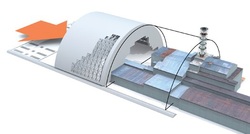 7. “WE’LL DIE OF SOMETHING ELSE” Construction workers completed ground preparations for the arch last spring. They have begun work on the two concrete ground beams that will fill the trenches, and between the beams lies a 100,000-square-yard concrete pad where the arch will be assembled. The pad is “contamination-free,” Kelly says. No anti-contamination gear will be required to work there, but each worker will carry an emergency respirator in case sensors detect radioactive aerosols blowing across the site. Out of Novarka’s 650-man workforce, not one worker appears to have exceeded his dose limit. That’s a remarkable achievement considering Chernobyl’s poor safety record. When Dodd first visited the plant in 1994, he says, safety conditions were “horrendous” and “appalling.” Most of the personnel didn’t have protective equipment. Radiation-detection portals in buildings around the plant didn’t work. In Pripyat, a city located near the plant that was abandoned days after the disaster, Chernobyl workers continued to swim in the community pool. SIP paid for new safety equipment, but money couldn’t buy a change in attitude, so it also installed a system to track individual radiation doses. Every worker wore a dosimeter clipped to his coveralls. If he went over his limit, he lost his job. Many workers responded by stashing their dosimeters in homemade lead boxes to keep their recorded doses below the limit. “Which is just crazy,” Dodd says. “The attitude was, ‘Well, we’ll die of something else.’ ” Two years ago, a wolf wandered near the construction site, sniffing around the doors of the facility where Novarka workers suit up before their shifts. It’s not unusual to see wolves, moose or packs of wild boar crossing the empty streets in Chernobyl’s exclusion zone. In fact, the resurgence of wildlife in certain areas has become something of a hazard. “Animals are vectors for contamination,” Fishburn says. “If they eat material that’s radioactive, they come here and they pee, and that spreads contamination.” The wolf that tried to get into the change facility bit six people, squared off with an ambulance, and killed a dog. A jittery cellphone video posted on YouTube documents part of the incident, revealing the Chernobyl workers’ casual regard for danger. In the video, they open a door and whistle to the wolf. Two men manage to corner the wolf and bludgeon it with a shovel and an oxygen canister while their comrades goad them on. Miraculously, the wolf escapes, sending the men fleeing, and the video ends. Guards later tracked down the wolf and shot it. Ill Wind: Fukushima Daiichi on March 14, 2011 Digital Globe/Getty Images 8. “FUKUSHIMA SAY IT AGAIN” Alexander Novikov is Chernobyl’s director of safety. He’s responsible for the health of everybody who works at the plant. I spoke to him one afternoon at a restaurant in Slavutych, a small city built for Chernobyl cleanup workers and former residents of Pripyat. Novikov chain-smoked strong Turkish cigarillos and spoke in halting English about the dangers that still existed inside the Shelter. “Twenty-five years after accident,” he said, “I’m afraid every day, because only fool cannot be afraid.”
I asked him for an example. About a year ago, Novikov said, he received a phone call in the middle of the night. The engineer on the other end of the line said that sensors had picked up traces of the radioisotope iodine-131. That meant only one thing: uncontrolled nuclear fission was occurring somewhere in the Shelter. The FCMs inside Unit 4 are fissile. If a chunk of concrete fell on one, it could alter the FCM’s internal geometry, triggering a nuclear chain reaction in what’s known as a “criticality event.” The FCM wouldn’t explode, but it would generate intense heat and radiation and could possibly melt through the concrete floor. If the FCM came into contact with water at this stage, it could cause a steam or hydrogen explosion and bring down the entire Shelter. “Twenty-five years after accident, I’m afraid every day, because only fool cannot be afraid.”Recalling the midnight phone call, Novikov put his hands around his throat and pretended to choke: “Oops!” Then he continued with his story. He instructed his engineers to check all nuclear sources at the plant and waited for results of the spectrometry analysis. “Report says iodine not Chernobyl.” Novikov smiled and lit another cigarillo. “Iodine is Fukushima.” Novikov volunteered as a dosimetrist during the cleanup in 1986, leaving briefly to recuperate from radiation exposure. Chernobyl is his life. He turns philosophical, almost superstitious, when talking about it. “Chernobyl from point of view of mankind is always,” he said. “A lot people think that when we build New Safe Confinement, all problems Chernobyl will be solved. I say when we build New Safe Confinement, the problem only begin.” The problem isn’t dismantling the Shelter or retrieving the FCMs. These are practical matters. The real problem, Novikov said, is time. Nuclear and radiological waste cannot be “cleaned up.” It cannot be eradicated. It can only be sealed in drums or concrete coffins and moved from one place to another, or buried in pits and surrounded by razor wire. In fact, no one yet has a plan for what to do with the FCMs. The arch is designed to last 100 years, and then it too will become debris for which some other engineer will have to devise a newer and safer confinement. “Chernobyl is not problem of Ukraine. It’s not problem of old Soviet Union. Fukushima say it again,” Novikov said as he tapped the ash off his cigarillo and jetted a thick plume of smoke from his lips. “Chernobyl is problem of whole world.” Steve Featherstone is a writer in Syracuse, New York. 2012 Military Wishlist Features Smart Wound-Diagnosing Uniforms and Dogfighting Drones By Stuart Fox Posted 04.25.2012 at 11:46 am 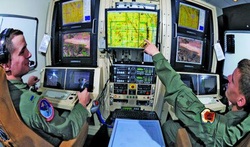 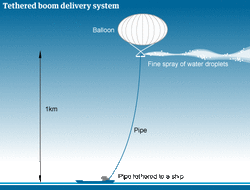 Field test by British academics marks first step towards recreating an artificial volcano that would inject particles into the stratosphere and cool the planet
But a team of British academics will next month formally announce the first step towards creating an artificial volcano by going ahead with the world's first major "geo-engineering" field-test in the next few months. The ultimate aim is to mimic the cooling effect that volcanoes have when they inject particles into the stratosphere that bounce some of the Sun's energy back into space, so preventing it from warming the Earth and mitigating the effects of man-made climate change. Before the full-sized system can be deployed, the research team will test a scaled-down version of the balloon-and-hose design. Backed by a £1.6m government grant, the team will send a balloon to a height of 1km over an undisclosed location. It will pump nothing more than water into the air, but it will allow climate scientists and engineers to gauge the engineering feasibility of the plan. Ultimately, they aim to test the impact of sulphates and other aerosol particles if they are sprayed directly into the stratosphere. If the technical problems posed by controlling a massive balloon at more than twice the cruising height of a commercial airliner are resolved, then the team from Cambridge, Oxford, Reading and Bristol universities expect to move to full-scale solar radiation tests. The principal investigator, Matthew Watson, a former UK government scientific adviser on emergencies and now a Bristol University lecturer, says the experiment is inspired by volcanoes and the way they can affect the climate after eruptions. "We will test pure water only, in sufficient quantity to test the engineering. Much more research is required," he said, in answer the question of what effect a planetary-scale deployment of the technology could have. Other leaders of the government-funded Stratospheric particle injection for climate engineering (Spice) project have investigated using missiles, planes, tall chimneys and other ways to send thousands of tonnes of particles into the air but have concluded that a simple balloon and hosepipe system is the cheapest. The research is paid for by the government-funded Engineering and Physical Sciences Research Council. "The whole weight of this thing is going to be a few hundred tonnes. That's the weight of several double-decker buses. So imagine how big a helium balloon do you need to hold several double-decker buses – a big balloon. We're looking at a balloon which is possibly 100-200m in diameter. It's about the same size as Wembley stadium," said the Oxford engineering lecturer Hugh Hunt in an interview earlier this year. "This hose would be just like a garden hose, 20km long and we pump stuff up the pipe. The nice thing about it is that we can really have a knob, if you like, which we can control to adjust the rate at which we inject these particles." While the October experiment is expected to have no impact on the atmosphere, it could also be used to try out "low-level cloud whitening", a geo-engineering proposal backed financially by Microsoft chairman and philanthropist Bill Gates. In this case, fine sea salt crystals would be pumped up and sprayed into the air to increase the number of droplets and the reflectivity in clouds. Together, many droplets are expected to diffuse sunlight and make a cloud whiter. However, environment groups in Britain and the US said the government's experiment was a dangerous precedent for a full-scale deployment that could affect rainfall and food supplies. Even if the approach successfully cools the planet by bouncing some of the Sun's energy back into space, it would do nothing for the build up of CO2 in the atmosphere, which leads to increased ocean acidity. "What is being floated is not only a hose but the whole idea of geo-engineering the planet. This is a huge waste of time and money and shows the UK government's disregard for UN processes. It is the first step in readying the hardware to inject particles into the stratosphere. It has no other purpose and it should not be allowed to go ahead," said Pat Mooney, chair of ETC Group in Canada, an NGO that supports socially responsible development of technology. Mike Childs, head of science, policy and research at Friends of the Earth UK, said: "We are going to have to look at new technologies which could suck CO2 out of the air. But we don't need to do is invest in harebrained schemes to reflect sunlight into space when we have no idea at all what impact this may have on weather systems around the globe." But the principle of large-scale geoengineering has been backed strongly by Sir Martin Rees, the former president of Royal Society, which in 2009 concluded in a report that it may be necessary to have a "plan B" if governments could not reduce emissions. "Nothing should divert us from the main priority of reducing global greenhouse gas emissions. But if such reductions achieve too little, too late, there will surely be pressure to consider a 'plan B' – to seek ways to counteract the climatic effects of greenhouse gas emissions by 'geoengineering'," said Rees. Members of the British public who were consulted by researchers in advance of the Spice experiment were broadly sceptical. "Overall almost all of our participants were willing to entertain the notion that the test-bed as an engineering test – a research opportunity – should be pursued. Equally, very few were fully comfortable with the notion of stratospheric aerosols as a response to climate change," the Cardiff University-based researchers concluded. Hacking the planet - potential geo-engineering solutionsOcean nourishment Billions of iron filings are deposited in the ocean to stimulate a phytoplankton bloom. The aim is to enhance biological productivity to remove carbon dioxide from the atmosphere. Many experiments have been conducted, including fertilisation of 900 square kilometers (350 sq miles) of the Atlantic. Results so far are disappointing. Space mirrors Giant "mirrors", made of wire mesh, could be sent into in orbit to deflect sunlight back into space. But the scale needed, the expense and the potential unintended consequences are so great that it is widely considered unrealistic. In the same league as the idea to mine the moon to create a shielding cloud of dust. Cloud whitening The idea is to increase the water content in low clouds by spraying sea water at them. This makes them reflect more sunlight. It would be pretty harmless, and cheap but would have to be done on an immense scale to have any global effect. Backed by Bill Gates. Artificial trees Proposed by climate scientist Wallace Broecker who imagines 60m artificial "trees" dotted around the world, "scrubbing" the air by capturing CO2 in a filter and then storing it underground. The trees could remove more carbon dioxide than an equivalent-sized real tree. Albedo changes Painting roofs and roads white, covering deserts in reflective plastic sheeting, dropping pale-coloured litter into the ocean and genetically engineering crops to be paler have all been proposed to reflect sunlight back into space. Carbon capture and storage (CCS) Carbon dioxide is collected from coal or other fossil fuel power plants and is then pumped underground. Works in principle but it is expensive and increases the fuel needs of a coal-fired plant by 25%-40%. More than 40 plants have been built with many others planned. • This article was amended on 7 September to remove a reference to the Royal Society 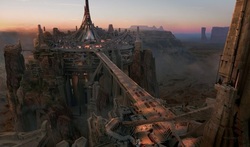 Director Andrew Stanton and production designer Nathan Crowley talk about Mars, John Carter, and building a 100-year-old science fiction universe Helium at Dusk Crowley remained as faithful to the book as he could in his rendering of the great city of Helium. "We know from the book that the city of Helium has a mile-high tower, and there’s just certain things you stick with, and that was very important. courtesy Disney _ Thermoelectric "Power Felt" Fabric Lets You Sit on Your Phone to Power It By Dan Nosowitz Posted 02.22.2012 at 1:22 pm  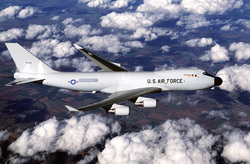 The Airborne Laser Test Bed Missile Defense Agency The Missile Defense Agency’s Airborne Laser Test Bed (ALTB) is dead after a long battle with Pentagon budgetary priorities and Congress. ALTB is best remembered for being a far-out directed-energy beam missile defense interceptor that dodged cancellation by the SecDef himself in 2010 by successfully zapping a test missile from the sky, earning it $40 million more and a new lease on life. But even ALTB couldn’t survive last week’s federal budget slashing. ALTB was sixteen years and several billion dollars old. It will be laid to rest at the the Air Force’s Maintenance and Regeneration Group, known as “The Boneyard.” It is survived by the Navy’s Free Electron Laser.  Earth’s clouds are sinking lower in the sky, with fewer clouds at high altitudes and lower cloudtops in general, says a new analysis of satellite data. The coming fog means that Earth will cool down more efficiently — so the lowering of clouds could slow the effects of global warming. This potential negative feedback loop is evident in about 10 years of satellite data, so not much at all in the grand scheme of climate research. But it’s a hint that something interesting is happening, according to Roger Davies, the lead researcher on a new paper based on findings from NASA’s Terra spacecraft. Related ArticlesLasers Could Create Clouds, and Perhaps Rain, on DemandChinese Government Plans to Cause Ten Percent More Rain By 2015Is Pollution Slowing Global Warming?TagsScience, Rebecca Boyle, climate change, clouds, earth satellites, global warming, nasa, Terra remote-sensing satelliteSeveral NASA assets look at clouds in a variety of ways, measuring their size, structure, formation, altitude and other vitals. The data is important for weather forecasting as well as long-term climate forecasting. Among other instruments, the Terra satellite contains nine cameras at different angles that produce 3-D images of clouds around the world. The satellite launched in 1999 and the new study examined its first decade of data. The data show that global average cloud height declined by roughly one percent over the decade, decreasing by around 100 to 130 feet. This was mostly the result of fewer clouds forming at the highest altitudes, according to a NASA release. Scientists are not sure why this happened, but it might be due to a change in atmospheric circulation patterns at high altitudes, Davies said. But they do know what it could mean: A drop in cloud height would allow more heat to escape the Earth into space, reducing the overall temperature of the planet. So differences in cloud formation, wrought by a warming climate, could help counteract the effects of that warming. For all their impact on our weather and our moods, clouds are one of the most poorly understood variables in climate change models. Terra and other cloud-watchers, notably CloudSat, aim to improve cloud representation in those models. Terra is scheduled to keep gathering this type of data for another decade, so maybe by 2020 we’ll know what the clouds are up to. Horses Big and Small This illustration shows the ancient horse ancestor Sifrhippus sandrae (right) touching noses with a modern Morgan horse, the latter which stands about 5 feet high at the shoulders and weighs 1,000 lbs. Sifrhippus, by contrast, was the size of a small house cat (about 8.5 lbs.) at the beginning of the Eocene (~55.8 million years ago). It is the earliest known horse. [Illustration by Danielle Byerley, Florida Museum of Natural History Back in the day of the first mammals, horses started out the size of house cats, weighing about 8 pounds and standing only a few inches tall. Then they got even littler, a direct result of the warm temperatures that characterized the Eocene era. Only when Earth cooled down a bit did the beasts get big, according to a new study — the first evidence that temperature directly affects body size. Interesting results when you think about rising global temperatures. Are Earth’s animals about to undergo a New Shrinkening? In about three-quarters of mammals, a truism called Bergmann’s rule holds that animals are smaller in hot climates and bigger in cold climates. Think about wooly mammoths versus Madagascan tenrecs. But a debate persists about why this is so, and whether it’s because of temperature itself or because of indirect results, like food abundance and conservation of heat energy. Ross Secord and colleagues set out to answer this question by studying horses from now and in the past. About 56 million years ago, the Earth warmed up during a phase known as the Paleocene-Eocene Thermal Maximum, or PETM. Carbon dioxide increased and global average temperatures rose by about 5 to 10 degrees Celsius. At least in horses, body sizes went down as temperature went up. Related ArticlesEndangered Wild Horses Get a Health CheckStem-Cell Therapy Works Wonders for Race Horses; Are Human Treatments Next?Europe Pledges Over $10 Billion for Climate Change Adaptation in Developing NationsTagsScience, Rebecca Boyle, animals, body plan, climate change, EVOLUTION, global warming, horses, paleontology, pint sizeThe little horse in the picture above is called Sifrhippus sandrae, and he is the earliest known horse. The species probably came to North America and Europe from a high-latitude land bridge that opened during the warming phase. After its arrival, its body size shrank by 30 percent over the next 130,000 years, Secord and colleagues say. They considered the dryness of environments, atmospheric pressure and even the nutritional content of plants exposed to higher levels of carbon dioxide, and ultimately conclude that temperature was the primary driver of size evolution in Sifrhippus. Their paper appears today in Science. So does this mean that global warming will make us all smaller? Taken to its furthest extent, this hypothesis sounds like some sort of Malthusian dream. Smaller humans would likely require less food. That means we would require less land on which to grow the food. Then we would use less fertilizer, and we’d need fewer factories to make fewer tractors to plow the fields on which we harvest the smaller amounts of food. Fewer factories=less energy requirements=fewer carbon dioxide emissions=less global warming? Sound crazy? Maybe, but I’m not the first person to say this. Philip Gingerich, a researcher at the University of Michigan who first noticed decreasing body size during the PETM, said he jokes about this all the time. “We're going to be walking around 3 feet tall if we keep going the way we're going,” he said. “Maybe that's not all bad and if that's the worst it gets, it will be fine. You can either adapt, or you go extinct, or you can move, and there's not a lot of place to move anymore, so I think it's a matter of adaptation and becoming smaller.” Like NASA’s new cloud-cooling study, this vision of the future is an almost poetic example of nature taking its course in spite of us. Things really do want to even out in the end. |
PTAH
ONE OF THE GREATEST INNOVATORS OF OUR TIME . PTAH WAS THE FIRST DURING THE GAS CRISIS TO LET ALL OF US Archives
July 2020
Categories |
|
|
- KAM
- don't jump into the pacific ocean or evacuate earth 'yeah nothing like that"
- sum moore
- Now it'z Our TIME
- The 1
- multipolar harmonicz
- laptop gate
- zaporozhye nuclear power plant news
- fukushima
- fallout/ radiation
- BOARDER BLOG
- terrorist state
- food now
- Climate change we must Change
- FOCUS FILMZ POLITICAL
- IZM GALLERY
- IZM TV/NEWS
- YOU KNOW WHO IT IZ
- ON YOUR BACK & BEYOND STYLE
- izm party
- Global biz
- ASCENDING MASTERS
- WHAT'Z UP WITH IT
- WORLD WIDE PEACE AND LOVE OR WAR
- JOURNEY OF PTAH
- INNOVATION
- tech/ cyber.S
- colonial semi yuanizm
- WHAT IZMIST DO
- GOLDEN AGE
- focus filmz
- cosmic alignment 2012
- THE PEACE AND LOVE FOUNDATION INC
- PROBLEMS IN LIES THE SOLUTION
- planet DISNEY
- melting pot
- fallout/radiation videos and info
- planet Elizabeth Taylor
- FOCUS FILMZ POLITICAL ON LOCATION
- we R the children
- books of knowledge
- Nu age
- TRUTHIZM" they will watch you die"
- CHEIF
- source of allmediaizm
- ptah messages from the beyond"
- COVID/19
- HEMP & CANOPY NEWZ
- CHINA BLUEIZM
- 4LIGHT IZ ZOUND


